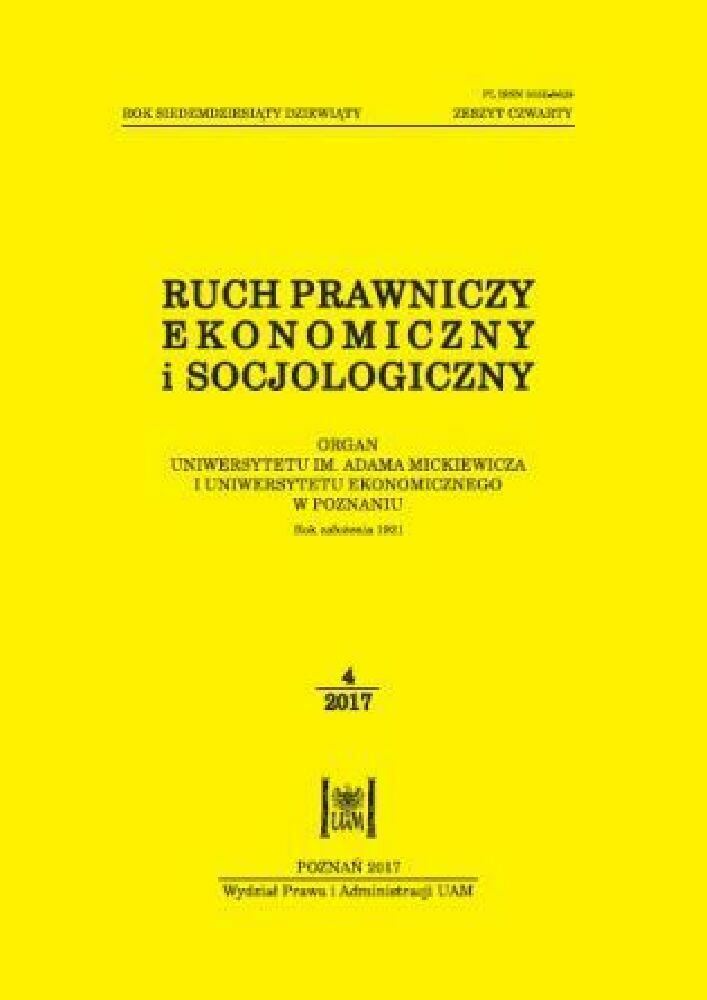Abstract
Sustainable development in Poland is a constitutional principle and therefore should underlie all actions. For this reason it should be expected that this principle be present in legal regulations concerning development policies at various levels of the territorial organisation, including the spatial policy. The possibility of the implementation of sustainable development in differentspatial scales is determined, among other things, by the manner in which population is distributed in a given area. The aim of the article is to define which settlement network, regionally and locally scale, will support the implementation of sustainable development. Next, the paper also aims to analyse whether there are references in Polish legal regulations to the development of a network that will be compatible with sustainable development. The analysis shows that it is predominantly a polycentric settlement structure that will help to achieve the objectives of such development, both on the regional and local scale. The Act on Planning and Spatial Development currently in force in Poland makes no references to the policy or regulations governing development of settlement networks, which may be one of the reasons for numerous inefficient, unsustainable spatial structures that can frequently be observed, as well as for the fact that the polarisation-diffusion model of development adopted in the Concept of the Spatial Development of the Country 2030 does not fully serve to achieve the objectives of sustainable development.
References
Bachtler, J. (ed.), (2001), Where is Regional Policy Going? Changing Concepts of Regional Policy, European Policies Research Centre, University of Strathclyde, www.eprc.strath.ac.uk/eorpa-/Documents/EoRPA_01_Papers/EoRPA_01-5.pdf [dostęp: 25.03.2011].
Brundtland, G.H. (1987), Our Common Future, WCED, Oxford University Press, Oxford.
Christaller, W. (1933), Die zentralen Orte in Süddeutschland. Eine ökonomisch-geographische Untersuchung über die Gesetzmäßigkeit der Verbreitung und Entwicklung der Siedlungen mit städtischen Funktionen, 66, Jena.
Dale, V.H., Efroymson, R.A., Kline, K.I., (2011), The land use-climate change – energy nexus. Landscape Ecology, 26: 755-773.
Delladetsima, P.M. (2012), Sustainable development and spatial planning: some considerations arising from the Greek case, European Journal of Spatial Development 46.
Fiedor, B. (2010), Kryzys gospodarczy a kryzys ekonomii jako nauki, Ekonomista 4: 453-466.
Fogel, P. (2014), Wskaźniki zrównoważonego rozwoju przestrzennego miasta, file:///E:/e_czasopisma/policentryzm/Fogel_artykul.pdf [dostęp: 8.07.2017].
Fujita, M., Krugman, P., Venables, A.J. (1999), The Spatial Economy: Cities, Regions and International Trade, MIT Press, Cambridge, MA.
Haughton, G. (1997), Developing sustainable urban development models, Cities 14(4): 189-95.
Horx, M. (2002), Die acht Sphären der Zukunft, Signum, Wien-München.
Kołodko, G.W. (2003), Nowa gospodarka– szanse i wyzwania, [w:] Piątkowski, M. (red.), Nowa gospodarka a transformacja, Wyd. WSPiZ im. L. Koźmińskiego w Warszawie, Warszawa.
Kozłowski, S. (2002), Ekorozwój: wyzwanie XXI wieku, WN PWN, Warszawa.
Krugman, P. (1991), Geography and Trade, Leuven University Press, Leuven.
Lösch A., (1962), Die räumliche Ordnung der Wirtschaft. Jena 1940, New edition: Fischer. Stuttgart.
Markowski, T. (2003), Warunki osiągania megaładu przestrzennego a system planowania przestrzennego, Biuletyn KPZK PAN, 205: 9-24.
Mierzejewska, L. (2004), Przyrodnicze aspekty rozwoju zrównoważonego, Bogucki Wydawnictwo Naukowe, Poznań.
Mierzejewska, L. (2009), Rozwój zrównoważony miasta: zagadnienia poznawcze i praktyczne, WN UAM, Poznań.
Mierzejewska, L. (2015), Miasto zwarte, rozproszone, zrównoważone, Studia Miejskie 19: 9-22.
Myrdal, G. (1957), Economic Theory and Underdeveloped Regions, Duckworth, London.
Nordic Centre for Spatial Development, ESPON 1.1.1. Potentials for polycentric development. Final Report, NORDREGIO, Sweden 2005.
Office of the Deputy Prime Minister – ODPM (2006), A common approach to creating sustainable communities: “The Bristol Accord”, Document 05 EUPMI 03656/A, [w:] UK
Presidency. EU Ministerial Informal on Sustainable Communities. Policy Papers, ODPM Publications, London, UK.
Olazabal, M., Urzelai, A., Garcia, G., Herranz, K., Abajo, B., Feliú, E., Santa Coloma, O., Aspuru, I. (2007), OIKOS: an integrated approach towards sustainable spatial planning and management, [w:] Horner, M., Hardcastle, C., Proce, A., Bebbington, J. (eds.), International Conference on Whole Life Urban Sustainability and its Assessment, Glasgow.
Parysek J., (2006), Wprowadzenie do gospodarki przestrzennej, WN UAM, Poznań.
Parysek, J. (2015), Rola lokalnego samorządu terytorialnego w rozwoju społeczno-gospodarczym i przestrzennym gmin, Ruch Prawniczy, Ekonomiczny i Socjologiczny. 77(2): 27-46.
Perroux, F. (1955), Note sur la notion du pôle de croissance, Économie appliquée 8: 307-320.
Petriṣor, A.I., Petriṣor, L.E. (2013), The shifting relationship between urban and spatial planning and the protection of the environment: Romania as a case study, Present Environment and Sustainable Development 7(1): 268-276.
Petriṣor, A.I., Sȃrbu, C.N. (2010), Dynamics of geodiversity and eco-diversity in territorial system, Journal of Urban and Regional Analysis 2(1): 61-70.
Piontek, F., Piontek, B. (2012), Zarządzanie rozwojem niszowym dla zapewnienia spójności społeczno-ekonomicznej, [w:] Woźniak, M.G. (red.), Nierówności Społeczne a Wzrost Gospodarczy, z. 24.
Rakowska, J. (2011), Praktyczne znaczenie zastosowania wyrównawczego lub polaryzacyjno-dyfuzyjnego modelu rozwoju regionalnego dla obszarów wiejskich w Polsce po 2013 roku, Wieś Jutra, Nauka Doradztwo Praktyka 11-12(160-161): 26-27.
Shipworth, D. (2002), Environmental Impact Mitigation is not sustainable development, Building Research and Integration 30: 139-142.
Strategy for a Regional Polycentric Urban System in Central Eastern Europe Economic Integrating Zone RePUS. NTERREG III B, http://www.espon-interstrat.eu/admin/attachments/ZL_dsresource.pdf [dostęp: 8.07.2017].
Szlachta, J. (2011), Strategiczne programowanie rozwoju regionalnego, w kierunku krajowego systemu myśli strategicznej w sferze polityki regionalnej, [w:] Nowy paradygmat rozwoju – najnowsze trendy i perspektywy rozwoju polityki regionalnej, Ministerstwo Rozwoju Regionalnego, Warszawa.
Wegener, M. (2013), Polycentric Europe: more Efficient, more Equitable and more Sustainable? Paper presented at the seminar Welfare and Competitiveness in the European Polycentric Urban Structure: Which Role for Metropolitan, Medium and Small Cities? at the Istituto Regionale Programmazione Economica dellaToscana (IRPET), Florence, 7 June 2013.
Wosiek, M. (2013), Uwarunkowania rozwoju regionów peryferyjnych w Polsce w czasach kryzysu finansów publicznych – wnioski dla spójności społeczno-ekonomicznej, Nierówności Społeczne a Wzrost Gospodarczy 31: 318-333.
Woźniak, M.G. (2012), Teoretyczne i praktyczne kwestie budowy spójności społeczno-ekonomicznej dla gospodarki innowacyjnej, [w:] Woźniak, M.G. (red.), Gospodarka Polski 1990-2011. Transformacja. Modernizacja. Spójność społeczno-ekonomiczna, t. 3: Droga do spójności społeczno-ekonomicznej, WN PWN, Warszawa.
License
Copyright (c) 2017 WPiA UAM

This work is licensed under a Creative Commons Attribution-NonCommercial-NoDerivatives 4.0 International License.




